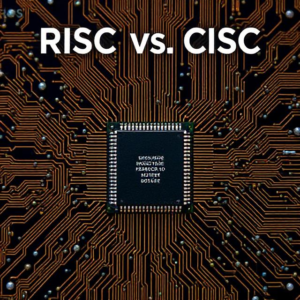RISC (Reduced Instruction Set Computing) and CISC (Complex Instruction Set Computing) are two types of computer processor architectures, and they differ in how they handle instructions to perform tasks. Let’s break it down in simple terms:

1. What is an Instruction?
An instruction is a command given to the processor to perform a task. For example, an instruction could tell the processor to add two numbers, move data from one place to another, or compare values. The way a processor handles these instructions is what makes RISC and CISC different.
2. What is RISC?
RISC stands for Reduced Instruction Set Computing. It uses a small set of simple, basic instructions. RISC processors focus on executing these simple instructions very quickly.
Key Features of RISC:
- Fewer Instructions: RISC processors have a small number of simple instructions that do one job at a time. For example, there might be one instruction to add numbers, one to load data into memory, and another to store data.
- Fast Execution: Since each instruction is simple, the processor can execute them very quickly—often in just one clock cycle (the time it takes to complete one basic operation).
- Efficiency: RISC uses more instructions to complete a task but can do each instruction very quickly.
Examples of RISC Processors:
- ARM (found in most smartphones)
- MIPS (used in some routers and embedded devices)
3. What is CISC?
CISC stands for Complex Instruction Set Computing. It uses a large set of more complex instructions, where each instruction can do more than one thing at once. This means each instruction might take longer to process, but you need fewer instructions to complete a task.
Key Features of CISC:
- More Instructions: CISC processors have a larger set of instructions, including more complex ones that can do multiple operations in a single instruction. For example, one instruction could add two numbers, store the result, and move data into memory—all in one step.
- Slower Execution: Since the instructions are more complex, it usually takes more clock cycles to execute them. But because fewer instructions are needed, this can still make it efficient for some tasks.
- Compact Code: Because each instruction can do more, the program might require fewer lines of code, which can save memory.
Examples of CISC Processors:
- Intel x86 (used in most desktop and laptop computers)
- AMD processors
4. Key Differences Between RISC and CISC
| Feature | RISC | CISC |
|---|---|---|
| Instruction Set | Simple, small set of instructions | Complex, large set of instructions |
| Execution Speed | Very fast (one instruction per cycle) | Slower (multiple cycles per instruction) |
| Number of Instructions | More instructions to complete tasks | Fewer instructions to complete tasks |
| Instruction Complexity | Simple, one operation per instruction | Complex, many operations per instruction |
| Memory Usage | Can require more memory for instructions | Can use less memory for instructions |
| Examples of Processors | ARM, MIPS | Intel x86, AMD |
5. When to Use RISC vs. CISC?
- RISC is great for situations where speed is key. For example, it’s used in smartphones and tablets where power efficiency and fast processing are crucial.
- CISC is better when you want to minimize the amount of code or reduce the number of instructions needed to perform complex tasks. It’s used in traditional computers (like desktops and laptops), where complex software can benefit from the powerful instructions CISC processors offer.
6. Which is Better?
It really depends on what you need:
- RISC tends to be faster at executing individual instructions, which makes it great for devices where efficiency and speed matter, like smartphones or embedded systems.
- CISC is good for tasks that involve running complex programs with lots of instructions, like desktop computers and servers, where reducing the number of instructions can be helpful.
Summary:
- RISC uses simpler, faster instructions that can execute quickly but might need more instructions to complete a task.
- CISC uses more complex instructions that can do multiple things at once, reducing the number of instructions but often taking more time to execute each one.
Tags: AMD processors, ARM processor, CISC, clock cycles, code size, compact code, Complex Instruction Set Computing, complex instructions, computer architecture basics, CPU architecture, desktop processors, Embedded Systems, fast execution, hardware architecture, instruction complexity, instruction execution, instruction handling, instruction set, instruction set difference, instruction speed, Intel x86, laptop processors, memory usage, MIPS processor, Power Efficiency, processor architecture, processor comparison, processor design, processor efficiency, processor performance, Reduced Instruction Set Computing, RISC, RISC vs CISC, simple instructions, Smartphone processors


